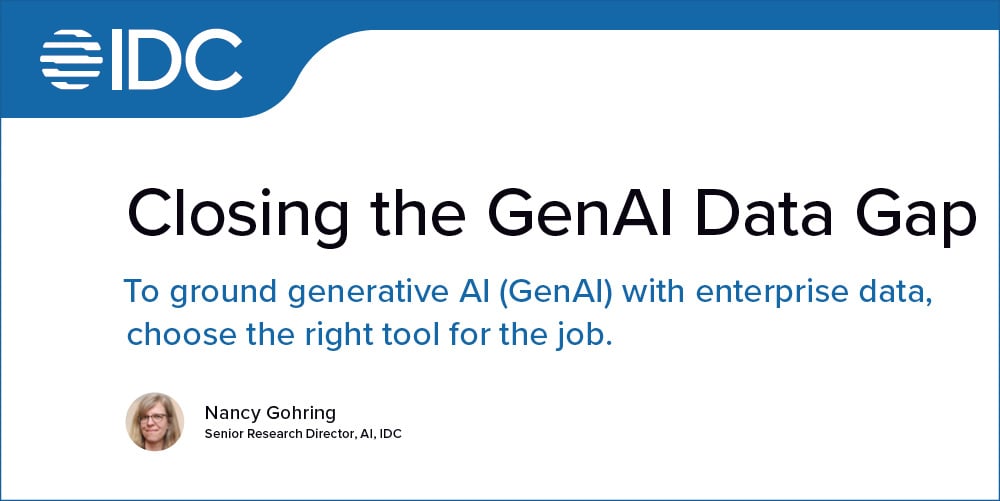GenAI data augmentation enhances AI models with structured, unstructured, and semi-structured data from enterprise systems for improved query responses.
The challenges of generative AI data augmentation
In the field of generative AI (GenAI) data augmentation, businesses recognize that effectively leveraging their data is essential. However, accessing this data can be complex. It may be structured, unstructured, or semi-structured, and each presents unique challenges. The success of utilizing this data often depends on the specific generative AI use cases and on the data retrieval approach.
Therefore, choosing the right Large Language Model (LLM) – and the right generative AI data augmentation method, such as Retrieval-Augmented Generation (RAG) – is crucial for delivering solutions that truly benefit customers and achieve business objectives.
Get the IDC report on closing the GenAI data gap FREE of charge.
Structured data in generative AI data augmentation
Structured data plays a vital role in the GenAI process. It includes valuable information found in systems such as Customer Relationship Management (CRM), Enterprise Resource Planning (ERP), and billing platforms. Given that this data can be sensitive and may contain Personally Identifiable Information (PII), it requires careful management. Additionally, structured data is often spread across different systems, making timely access challenging.
To effectively retrieve structured data for generative AI data augmentation, you could:
-
Query the systems that collect and store the data
For example, the LLM agent of an enterprise RAG can integrate with a CRM system – directly or through an API – to extract customer information like name, address, SSN, or products of interest.
-
Query data lakes or warehouses
LLM agents can also query and access data in data lakes or warehouses which consolidate data from multiple sources for easier access. Organizations typically use these big data stores for generating comprehensive reports or training AI models with a holistic view of customer behavior.
-
Use the most advanced data management system
For example, a Data Product Platform prepares data and organizes it around a business entity, like a customer, by unifying, cleansing, and organizing it for real-time accessibility. It’s ideal for GenAI scenarios where data quality, protection, and real-time access are key.
Regardless of the method chosen, converting text to Structured Query Language (SQL) is crucial for communicating with relational database management systems. LLM text-to-SQL tools translate natural language queries into SQL, making it possible for non-technical users to access structured data.
Key concerns for generative AI data augmentation
When determining how to make structured data available for generative AI, it’s important to consider several important factors:
-
Security and privacy
Deploying a generative AI application involves significant risks, including potential legal and reputational consequences. The way data is stored and accessed has a significant impact on a company’s exposure to these risks. Sensitive data requires enhanced security measures. It’s crucial to assess data storage options, establish strong governance policies, and implement security protocols that align with both the company’s risk tolerance and the application’s needs. For example, if you’re implementing a RAG chatbot, your customers should be able to access only their individual data and nobody else’s, and that the appropriate data masking policies are in place.
-
Timeliness of data
For many GenAI applications, having access to up-to-date information is key to delivering accurate responses. For example, AI-powered customer support applications can let you know if a customer has made a payment in the last 5 minutes – but be careful because not every RAG architecture supports real-time data access. You’d also need to know how fresh your data needs to be and choose storage and access methods accordingly.
-
Cost
Preparing data for generative AI data augmentation means meeting your organization’s data readiness standards, including the cost of moving, cleansing, querying, and organizing data. Other cost factors include your application architecture, data requirements, query types, and updating frequency.
-
Scale
As organizations transition from GenAI pilot programs to full-scale deployments, the volume of data and the number of concurrent users will increase significantly. Anticipating these scale requirements is critical when selecting data stores and the enterprise RAG that will ensure optimal application performance over time. It’s also important to ensure conversational latency at high scales.
-
Quality and reliability
Successful generative AI data augmentation must deliver accurate and timely outputs. While the choice of the model and its deployment strategy is important, the architecture of your data store also plays a crucial role in ensuring AI data quality and reliability. Because structured data is often spread across different systems, combining the data from these sources and understanding which sources are more reliable, current, and compliant is critical.
Recommendations for GenAI data augmentation
Where structured data resides and how you can access and retrieve it is just one of many factors impacting the reliability, performance, and security of a generative AI application – but it also impacts your LLM’s capabilities. Today, companies seeking to leverage the full potential of generative AI data augmentation need tools to ensure secure, reliable, and immediate access to structured and unstructured data, wherever it may be.
Advanced RAG software solutions promise to bridge the data gap by delivering secure and immediate access to structured data. As a result, LLMs can respond accurately and effectively to any query.
K2view marks a paradigm shift in data access
Traditional methods of accessing structured data – whether through direct system queries or by fishing data lakes – come with inefficiencies, high costs, and security risks. Patented technology by K2view transforms this landscape by isolating all data related to a single business entity (say, customer) and organizing it so that’s it’s ready for GenAI consumption.
GenAI Data Fusion, RAG tools developed by K2view, lets you access structured data quickly and securely – easily overcoming the limitations of traditional methods. For example, continuous sync and cleansing processes ensure that your data is always accessible and fresh, so that your LLM responses are always accurate and meaningful.
Discover GenAI Data Fusion, the RAG tools of choice for generative AI data augmentation.














